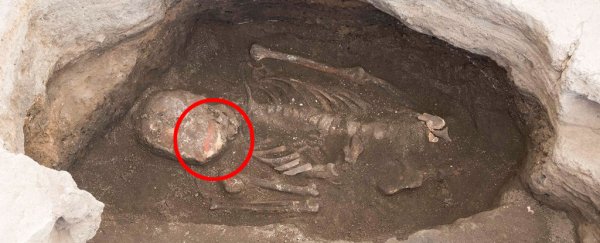The sprawling ruins of Çatalhöyük – a vast, ancient human settlement in what we now know as Turkey – are much like a precursor to the modern metropolis of today. Yet, over the course of 9,000 years, times have certainly changed.
Çatalhöyük, often described as one of the world's oldest cities, was one of the largest Neolithic settlements in Anatolia, providing a home for up to 8,000 people at its peak, after its founding in approximately 7100 BCE.
But while this sprawling city of the past shares many similarities with modern urban centers, striking contrasts are also apparent.
 Hand print on wall. (Jason Quinlan/Çatalhöyük Research Project)
Hand print on wall. (Jason Quinlan/Çatalhöyük Research Project)
One of the most obvious: Çatalhöyük had no streets. Dwellings were constructed directly alongside each other, so that the only way to enter buildings was to climb down into them from the rooftop.
Once inside, even if nobody was around, you were not alone. The people of Çatalhöyük buried their dead inside their homes, underneath the floor.
"Adults were most often placed in a flexed position, located beneath the northern and eastern platforms of the central room," a team of researchers, led by first author and archaeo-anthropologist Eline Schotsmans from the Université de Bordeaux in France, explains in a new study analyzing the funerary practices of ancient Çatalhöyük.
"Perinate, neonate, and infants were buried in more variable locations within the house."
Burial placement wasn't the only custom unusual by our modern Western standards. Çatalhöyük's skeletons were sometimes ritualistically painted before burial, although much has remained unknown about the specifics of the pigments used – and the symbolism of their colorings.
In the new study, Schotsmans and fellow researchers examined the skeletal remains of former Çatalhöyük individuals, over 800 of whom have been excavated since the early 1990s; the team also analyzed the pigments used on them (or on associated burial items) with an X-ray fluorescence spectrometer.
 Detail of cinnabar stripe on cranium of male individual. (Marco Milella)
Detail of cinnabar stripe on cranium of male individual. (Marco Milella)
Ultimately, only a small minority of Çatalhöyük's dead (about 6 percent of the individuals studied here) were directly treated with pigments, while 11 percent featured pigment on grave items buried with the deceased, such as stained shells, bowls, baskets, and bone objects.
Pigments applied to skeletal remains were always red in color (usually on the cranium), with red ochre being the most commonly used pigment. More males than females received direct treatment with pigment, and adults were also slightly more likely than children to be painted.
Less common pigments seem to have reflected the social identity of the deceased, the researchers observe, with cinnabar (a red form of mercury sulfide) reserved largely for males, and either directly painted onto bone, or absorbed from red headbands the men wore while alive or when buried after death.
Meanwhile, blue and green pigments on burial items were solely limited to females and children.
"These colors have sometimes been associated with concepts of growth, fertility, and ripeness, which are abstractions that could be related to the transition to agriculture," the researchers write, although they note that the limited sample size of the colorants found so far limits our ability to interpret the discoveries.
What is clear, however, is that there's some kind of link between the numbers of burials within a dwelling and layers of painting found on the walls above the grave.
"This means: when they buried someone, they also painted on the walls of the house", says senior researcher and anthropologist Marco Milella from the University of Bern in Switzerland.
 Geometric wall painting inside building. (Jason Quinlan/Çatalhöyük Research Project)
Geometric wall painting inside building. (Jason Quinlan/Çatalhöyük Research Project)
Aside from the issue of pigment, not everybody in Çatalhöyük was buried in the same way, or perhaps buried at all. Among the human remains found in the ancient city, some have never been disturbed since Neolithic times, while others were interfered with by subsequent Neolithic activity, with evidence of disarticulated skeletons or isolated bones.
This could potentially mean that skeletal elements were sometimes dug up in ancient Çatalhöyük, with the bones of deceased individuals serving some form of symbolic role in the community, before later being buried again.
"Other individuals, either as complete bodies or loose skeletal elements, remained in the community," the researchers write.
"These circulating skeletal elements were eventually deposited in secondary or tertiary deposition contexts, which may also have been linked to the creation of architectural paintings in an indirect way."
As for what purpose this served, it's impossible to know for sure, but the researchers say the continued use of excavated human remains within the community could have been a way of keeping the memory of those people alive, in a manner of speaking.
"According to socio-cultural anthropologists, collective memory is handed down from generation to generation through repetition of past actions and by direct object-to-memory association," the researchers explain.
"Intramural burials may have been a part of processes of memory retention with each interment contributing to communal memory by keeping the deceased close to the daily rhythm of repeated household activities."
The findings are published in Scientific Reports.
